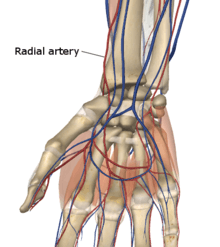Radial artery puncture
Radial artery puncture is a medical procedure performed to obtain a sample of arterial blood for gas analysis. A needle is inserted into the radial artery and spontaneously fills with blood. The syringe is either prepacked with a small amount of heparin to prevent coagulation, or must be heparinised, by drawing up a small amount of heparin and squirting it out again.

Most commonly, radial artery puncture is performed to obtain arterial blood sampling for gas analysis. The partial pressures of oxygen (PaO2) and carbon dioxide (PaCO2), and the pH of arterial blood are important in assessing pulmonary function. These data indicate the status of gas exchange between lungs and blood.
Radial artery puncture can also be used for coronary catheterization through percutaneous coronary intervention (PCI).
Contraindications
- Cellulitis or other infections over the radial artery
- Absence of palpable radial artery pulse
- A negative Allen test (see below), which indicates that only one artery supplies the hand. A positive Allen test indicates the blood supply to the hand is normal.
- Coagulation defects (relative)
Allen test
It is important to perform an Allen test to confirm the patency of the ulnar artery—because, with no collateral flow through the ulnar artery, radial artery puncture can result in a gangrenous finger or loss of the hand from spasm or clotting of the radial artery. The Allen test is performed with the patient sitting with hands resting on knees. A medical professional stands at the patient's side with fingers around the patient's wrist and compresses the tissue over both radial and ulnar arteries for a few minutes—waiting for the blood to drain from the hand while the patient opens and closes the hand several times. Releasing pressure on the ulnar artery while keeping the radial artery occluded should return normal skin color to the ulnar side of the palm in one to two seconds, followed by quick restoration of normal color to the entire palm. A hand that remains white indicates either absence or occlusion of the ulnar artery, and radial artery puncture is contraindicated.
Anatomical review
The radial artery runs along the lateral aspect of the volar forearm deep to the superficial fascia. The artery runs between the styloid process of the radius and the flexor carpi radialis tendon. The point of maximum pulsation of the radial artery can usually be palpated just proximal to the wrist.